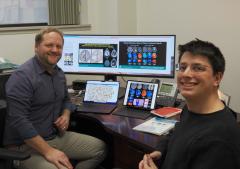How can oncologists treat what they cannot see? Scientists at the Medical College of Wisconsin (MCW) have discovered the presence of cancerous tissue that is undetectable by even the most sophisticated medical imaging techniques.
To better understand this problem, Peter LaViolette, PhD ’11, PDF (postdoctoral fellow) ’12, MS, holder of the Robert C. Olson, MD, Professorship in Radiology and MCW associate professor of radiology and biomedical engineering, and Sam Bobholz, PhD ’22, MCW postdoctoral fellow, developed partnerships with a team of collaborators at MCW and two California medical schools. The group studied 159 tissue samples from 65 deceased patients who suffered from brain cancer.
“We used MRI scans from the patients to determine precise measurements and print unique 3-D molds to match each brain,” Dr. LaViolette says. This mold allows the brain to be sliced and processed into glass slides that accurately match the corresponding MRI scan. The team’s pathologists analyzed the tissue for tumor severity and location before sending annotated images to Drs. LaViolette and Bobholz.
“Next, we employed a machine learning program to read and compare the hundreds of pathologist annotated slides and the MRI data,” Dr. Bobholz notes. Machine learning is a rapidly growing and evolving approach to analyzing and interpreting massive amounts of data. Unlike traditional programming that requires scientists to provide a computer with every parameter of a problem using handwritten code, machine learning developers and scientists apply artificial intelligence to set up frameworks through which computers learn on their own.
The team’s findings demonstrate a significant subset of brain cancer patients who one day may benefit from clinical application of this mapping technique. By revealing these otherwise hidden boundaries of tumors, cancer progression may be able to be monitored with greater precision, and future surgeries and targeted radiation treatments may become more effective, reducing the chance of recurrence.

